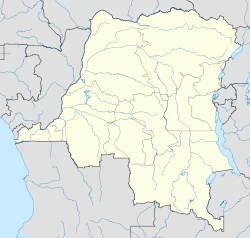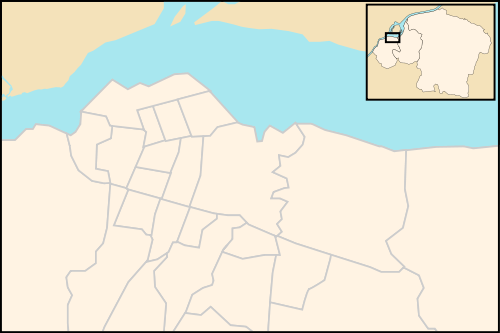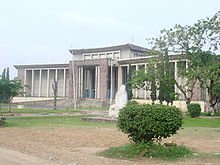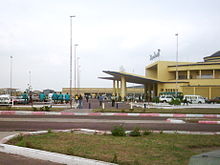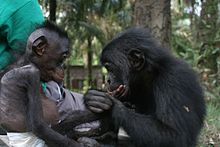
Kinshasa
Did you know...
This wikipedia selection has been chosen by volunteers helping SOS Children from Wikipedia for this Wikipedia Selection for schools. A quick link for child sponsorship is http://www.sponsor-a-child.org.uk/
| Kinshasa Ville de Kinshasa |
|||
|---|---|---|---|
| — Ville-province (city-province) — | |||
| Kinshasa with Congo river in background | |||
|
|||
| Nickname(s): Kin la belle (English: Kin the beautiful) |
|||
| DRC, highlighting the city-province of Kinshasa | |||
|
|
|||
| Coordinates: 4°19′30″S 15°19′20″E Coordinates: 4°19′30″S 15°19′20″E | |||
| Country | |||
| Province | Kinshasa | ||
| Administrative HQ | La Gombe | ||
| Communes |
List
|
||
| Government | |||
| • Governor | André Kimbuta | ||
| Area | |||
| • City-province | 9,965 km2 (3,848 sq mi) | ||
| • Urban | 583 km2 (225 sq mi) | ||
| Elevation | 240 m (790 ft) | ||
| Population (2012) | |||
| • City-province | 9,046,000 | ||
| • Density | 910/km2 (2,400/sq mi) | ||
| • Urban | 9,046,000 | ||
| • Urban density | 16,000/km2 (40,000/sq mi) | ||
| • Language | French | ||
| Area code(s) | 234 + 12 | ||
| Website | www.kinshasa.cd | ||
Kinshasa (formerly French Léopoldville, and Dutch Leopoldstad) is the capital and the largest city of the Democratic Republic of the Congo. The city is located on the Congo River.
Once a site of fishing villages, Kinshasa is now an urban area with a population of 9 million inhabitants. It faces the capital of the neighbouring Republic of Congo, Brazzaville, which can be seen in the distance across the wide Congo River. The city of Kinshasa is also one of the DRC's 11 provinces. Because the administrative boundaries of the city-province cover a vast area, over 90% of the city-province's land is rural in nature, and the urban area only occupies a small section in the far western end of the city-province.
Kinshasa is the second largest city in Africa after Lagos. It is also the second largest " francophone" urban area in the world after Paris, French being the language of government, schools, newspapers, public services and high-end commerce in the city, while Lingala is used as a lingua franca in the street. If current demographic trends continue, Kinshasa should surpass Paris in population around 2020. Kinshasa hosted the 14th Francophonie Summit in October 2012.
Residents of Kinshasa are known as Kinois (in French and sometimes in English) or Kinshasans (English).
History
The city was founded as a trading post by Henry Morton Stanley in 1881 and named Léopoldville in honour of King Leopold II of Belgium, who controlled the vast territory that is now the Democratic Republic of the Congo, not as a colony but as a private property. The post flourished as the first navigable port on the Congo River above Livingstone Falls, a series of rapids over 300 kilometres (190 mi) below Leopoldville. At first, all goods arriving by sea or being sent by sea had to be carried by porters between Léopoldville and Matadi, the port below the rapids and 150 km (93 mi) from the coast. The completion of the Matadi-Kinshasa portage railway in 1898 provided a faster and more efficient alternative route around the rapids and sparked the rapid development of Léopoldville. By 1920, the city was elevated to capital of the Belgian Congo, replacing the town of Boma in the Congo estuary.
In 1965, Joseph-Désiré Mobutu seized power in the Congo in his second coup and initiated a policy of " Africanizing" the names of people and places in the country. In 1966, Léopoldville was renamed Kinshasa for a village named Kinchassa that once stood near the site. The city grew rapidly under Mobutu, drawing people from across the country who came in search of their fortunes or to escape ethnic strife elsewhere. This inevitably brought about a change to the city's ethnic and linguistic composition as well. Although it is situated in territory that traditionally belongs to the Bateke and Bahumbu people, the lingua franca among African languages in Kinshasa today is Lingala while the administrative and main written language is French, see further Languages of the Democratic Republic of the Congo.
In 1974, Kinshasa hosted ' The Rumble in the Jungle' boxing match between Muhammad Ali and George Foreman, in which Ali defeated Foreman to regain the World Heavyweight title.
Kinshasa suffered greatly due to Mobutu's excesses, mass corruption, nepotism and the civil war that led to his downfall. Nevertheless, it is still a major cultural and intellectual center for Central Africa, with a flourishing community of musicians and artists. It is also the country's major industrial centre, processing many of the natural products brought from the interior. The city has recently had to fend off rioting soldiers who were protesting the government's failure to pay them.
Kinshasa had the earliest documented HIV-1 infection, which dates from 1959 and was discovered in the preserved blood sample of a local man (see AIDS origin).
Administration
Kinshasa is both a city (ville in French) and a province (province in French), one of the 11 provinces of the Democratic Republic of the Congo. Its status is thus similar to Paris which is both a city and one of the 101 departments of France.
Administrative divisions
The ville-province (city-province) of Kinshasa is divided into four districts which are further divided into 24 communes (municipalities).
| Bandalungwa | Barumbu | Kisenso (Kinsenso) | Kimbanseke |
| Bumbu | Gombe (La Gombe) | Lemba | Maluku |
| Kalamu | Kinshasa | Limete | Masina |
| Kasa-Vubu | Kintambo | Matete | Ndjili (N'Djili) |
| Makala | Lingwala | Ngaba | Nsele (N'Sele) |
| Ngiri-Ngiri | Mont Ngafula | ||
| Selembao | Ngaliema |
|
||
|
Abbreviations : Kal. (Kalamu), Kin. (Kinshasa), K.-V. (Kasa-Vubu), Ling. (Lingwala), Ng.-Ng. (Ngiri-Ngiri)
|
Geography
Kinshasa is a city of sharp contrasts, with affluent residential and commercial areas and three universities coexisting side by side with sprawling slums.
It is located along the south bank of the Congo River, directly opposite the city of Brazzaville, capital of the Republic of the Congo. This is the only place in the world where two national capital cities are facing one another and in sight of each other on opposite banks of a river.
The Congo river is the second longest river in Africa after the Nile, and is the largest in terms of discharge. As a waterway it provides a means of transport for much of the Congo basin, being navigable for large river barges between Kinshasa and Kisangani, and many of its tributaries are navigable too. The river is an important source of hydroelectric power, and downstream of Kinshasa it has the potential to generate power equivalent to the usage of roughly half of Africa's population.
Climate
Under the Köppen climate classification, Kinshasa has a Tropical wet and dry climate. It features a lengthy rainy season which spans from October through May and a relatively short dry season which runs between June and September. Due to fact that Kinshasa lies south of the equator, its dry season begins around its "winter" solstice, which is in June. This is in contrast to African cities further north featuring this climate where the dry season typically begins around January. Kinshasa's dry season is slightly cooler than its wet season, though temperatures remain relatively constant throughout the year.
| Climate data for Kinshasa | |||||||||||||
|---|---|---|---|---|---|---|---|---|---|---|---|---|---|
| Month | Jan | Feb | Mar | Apr | May | Jun | Jul | Aug | Sep | Oct | Nov | Dec | Year |
| Record high °C (°F) | 36 (97) |
36 (97) |
36 (97) |
36 (97) |
35 (95) |
34 (93) |
32 (90) |
35 (95) |
36 (97) |
36 (97) |
34 (93) |
36 (97) |
36 (97) |
| Average high °C (°F) | 31 (88) |
31 (88) |
32 (90) |
32 (90) |
31 (88) |
29 (84) |
27 (81) |
29 (84) |
31 (88) |
31 (88) |
31 (88) |
30 (86) |
30 (86) |
| Average low °C (°F) | 21 (70) |
22 (72) |
22 (72) |
22 (72) |
22 (72) |
19 (66) |
18 (64) |
18 (64) |
20 (68) |
21 (70) |
22 (72) |
21 (70) |
21 (70) |
| Record low °C (°F) | 18 (64) |
18 (64) |
18 (64) |
19 (66) |
18 (64) |
15 (59) |
14 (57) |
14 (57) |
16 (61) |
15 (59) |
17 (63) |
17 (63) |
14 (57) |
| Rainfall mm (inches) | 135 (5.31) |
145 (5.71) |
196 (7.72) |
196 (7.72) |
159 (6.26) |
8 (0.31) |
3 (0.12) |
3 (0.12) |
30 (1.18) |
119 (4.69) |
222 (8.74) |
142 (5.59) |
1,358 (53.47) |
| Avg. rainy days | 11 | 11 | 12 | 16 | 12 | 1 | 0 | 1 | 5 | 11 | 16 | 15 | 111 |
| Mean monthly sunshine hours | 124 | 140 | 155 | 150 | 155 | 120 | 124 | 155 | 120 | 155 | 150 | 124 | 1,672 |
| Source: BBC Weather | |||||||||||||
Buildings and institutions
Major areas of the city include the Cité de l'OUA, home to the Government of the Democratic Republic of the Congo, quartier Matonge, known regionally for its nightlife, L'ONATRA, the impressive building of the Ministry of Transport and the residential area of Gombe.
Notable features of the city include the SOZACOM Building and Hotel Memling skyscrapers, the central market, the Kinshasa Museum and the Kinshasa Fine Arts Academy. The Boulevard du 30 Juin (Boulevard of the 30 June) links the main areas of the city. Kinshasa is home to the country's national stadium, the Stade des Martyrs (Stadium of the Martyrs).
Industries
Marsavco Sarl Biggest FMCG Manufacturing Company located in centre of town (Gombe) in Kinshasa.
There are many other industries such as, Trust Merchant Bank located in the heart of the city as well as court reporting.
Social issues
Crime
Street children
Street children, often orphaned, are subject to abuse by the police and military. Of the estimated 20,000 children – up to the age of eighteen – living rough in Kinshasa's street, almost a quarter are beggars, some are street vendors and about a third have some kind of employment. Some are there as fallout from the times of war; others are accused of witchcraft and have become outcasts.
Police regularly round up street children, to an uncertain fate; there are recorded incidents of children being shot dead by police for minor misdemeanours.
Education
Kinshasa is home to several higher-level education institutes, covering a wide range of specialities, from civil engineering to nursing and journalism. The city is also home to three large universities and an arts school:
- Prins van Luik School / Lycée Prince de Liège (primary and secondary education, Belgian curriculum)
- University of Kinshasa
- Université Libre de Kinshasa
- Congo Protestant University
- National Pedagogy University
- National Institute of Arts
- Allhadeff School
- Centre for Health Training (CEFA)
Medicine
There are twenty hospitals in Kinshasa, plus various medical centres and polyclinics. In 1997, Dikembe Mutombo built a 300-bed hospital near his home town of Kinshasa. Since 1991, Monkole Hospital is working as a non-for profit health institution collaborating with the Health Department as district hospital in Kinshasa. Directed by Pr Léon Tshilolo, paediatrician and haematologist, Monkole Hospital is opening a new 150-bed building in 2012 with improved clinical services as laboratory, diagnostic radiology, intensive care, neonatal unit, family medicine, emergencies unit and a larger surgical area.
Music
60 Minutes featured a story about the 200-member Kimbanguist Symphony Orchestra. It's the only symphony orchestra in central Africa and the only all-black orchestra in the world. Former commercial pilot, Armand Diangienda, taught himself how to read music and play several instruments after his airline shut down. He began the amateur orchestra in the city of Kinshasa from literally nothing in one of the poorest, war-torn countries in the world. Some of the musicians travel miles over rocky dirt roads to come to rehearsal.
Language
The official language of the Democratic Republic of the Congo, of which Kinshasa is the capital, is French (See: Kinshasa French vocabulary). Kinshasa is the second largest officially Francophone city in the world although Lingala is widely used as a spoken language. French is the language of street signs, posters, newspapers, government documents, schools; it dominates plays, television, and the press, and it is used in vertical relationships among people of uneven rank; people of equal rank, however, speak the Congolese languages (Kikongo, Lingala, Tshiluba or Swahili) among themselves. Thus, while the culture is dominated by the Francophonie, a complex multilingualism is present in Kinshasa.
Transport
Several private companies whose Urban Transport Company (STUC) and the Public City train (12 cars in 2002) serves the city. The bus lines are:
- Gare centrale – Kingasani (municipality of Kimbanseke, reopened in September 2005);
- Kingasani – Marché central
- Matete – Royale (reopened in June 2006);
- Matete – UPN (reopened in June 2006);
- Rond-point Ngaba – UPN (reopened in June 2006).
- Rond-point Victoire – clinique Ngliema (opened in March 2007)
Other companies also provide public transport: Urbaco, Tshatu Trans, Socogetra, Gesac and MB Sprl. The city bus carries a maximum of 67,000 passengers per day. Several companies operate taxis and taxi-buses. The majority (95.8%) of transport is provided by individuals.
The city is considering the creation of a tramway in collaboration with public transport in Brussels (STIB), whose work could start in 2009 and would be completed around 2012–2015. The issue of electricity remains suspended.
Air
Air travel to DRC Congo is made possible by several airlines serving the country, including Kenya Airways, Air Gabon, Cameroon Airlines, Bravo Air Congo, Air Zimbabwe, South African Airways, Ethiopian Airlines, KLM and Air France.
Kinshasa (Ndjili) International Airport (FIH) in Kinshasa the capital city is the major airport of the country. Other airports include Lubumbashi airport in Lubumbashi, Bangoka airport in Kisangani and Goma airport.
Long awaited Congolese airline startup, Korongo Airlines, launched operations on 16th April 2012. The airline is partly owned by Brussels Airlines and will begin operations with a single Boeing 737-300 and a BAe 146. The airline had been in preparations for a couple of years but had had various difficulties in getting the necessary government approvals from DRC. Korongo Airlines is based in Lumbumbashi where maintenance is performed by Brussels Airlines. There are other local airlines for domestic flights such as Congo Air, CAA.
Rail
The ONATRA operates three lines of urban railways linking the town centre device, which goes to Bas-Congo.
- The main line linking the Central Station to the N'djili Airport has 9 stations: Central Station, Ndolo, Amicongo, Uzam, Masina / Petro-Congo, Masina wireless Masina / Mapela, Masina / Neighbourhood III, Masina / Siforco Camp Badara and Ndjili airport.
- The second line connects the Central Station in Kasangulu in Bas-Congo, through Matete, Riflart and Kimwenza.
- The third line at the Central Station Kinsuka-pumping in the town of Ngaliema.
In 2007, the internal rail network is being renovated with the help of Belgium. This would serve Kintambo, Ndolo, Limete, Lemba, Kasangulu, Gombe, Ndjili and Masina.
External transport
Kinshasa is the major river port of the Congo. The port, called 'Le Beach Ngobila' extends for about 7 km (4 mi) along the river, comprising scores of quays and jetties with hundreds of boats and barges tied up. Ferries cross the river to Brazzaville, a distance of about 4 km (2 mi). River transport also connects to dozens of ports upstream, such as Kisangani and Bangui.
There are road and rail links to Matadi, the sea port in the Congo estuary 150 km (93 mi) from the Atlantic Ocean.
There are no rail links from Kinshasa further inland, and road connections to much of the rest of the country are few and in poor condition.
The city has two airports: N'djili Airport is the main airport with connections to other African countries as well as to Brussels, Paris and some other destinations. N'Dolo Airport, located close to the city centre, is used for domestic flights only with small turboprop aircraft.
Conservation
Lola ya Bonobo
Founded by Claudine André in 1994, Lola ya Bonobo is the world's only sanctuary for orphaned bonobos. Since 2002, the sanctuary has been located at Les Petites Chutes de la Lukaya, just outside of Kinshasa Lola ya Bonobo means 'paradise for bonobos' in Lingala, the main language of Kinshasa. In 2008, Lola ya Bonobo was home to 60 bonobos who live in 30 hectares of primary forest.
Kinshasans
- David Norris, scholar and politician, 2011 election candidate for President of Ireland
- D. J. Mbenga, professional basketball player for the Los Angeles Lakers in the US National Basketball Association.
- Christian Eyenga, professional basketball player and 2009 first round draft choice for the Cleveland Cavaliers in the US National Basketball Association.
- Dikembe Mutombo, retired professional basketball player
- Jimmy Omonga, singer-songwriter.
- Christian M'Pumbu, professional mixed martial arts fighter and current Bellator Fighting Championships World Champion
- Ya Kid K, hip-hop artist.
- Guylain Ndumbu-Nsungu, former Sheffield Wednesday football player.
- Leki, R&B artist.
- Claude Makélélé, professional football player for Paris Saint-Germain in the French Ligue 1.
- Steve Mandanda, professional footballer who plays for Marseille and the France national football team.
- Ariza Makukula, naturalized Portuguese professional football player for Kayserispor in the Turkish Süper Lig, on loan from Sport Lisboa e Benfica of the Primeira Liga.
- José Bosingwa, naturalized Portuguese football player for Chelsea of the Premier League in England.
- André Action Diakité Jackson or M’zée Fula-Ngenge, diamond mogul.
- Leroy Lita, professional football player for Welsh club Swansea City in the English Premier League.
- Jessy Matador, singer
- Fabrice Muamba, professional football player player for Bolton Wanderers in the Premier League.
- Odette Krempin, fashion designer.
- Tim Biakabutuka, former professional American football player.
- Kaysha, hip-hop artist.
- Kazenga LuaLua,professional football player for Newcastle United.
- Lomana LuaLua, professional football player for Al-Arabi in Qatar.
- Mwamba Kazadi, former professional football player who won the 1973 " African Footballer of the Year" award.
- Péguy Luyindula, professional football player for Paris Saint-Germain in the Ligue 1.
- Hérita Ilunga, professional football player for West Ham United in the Premier League.
- Gary Kikaya, Olympic 400 metre runner
- Patrick Kabongo, professional football player for the Edmonton Eskimos of the Canadian Football League.
- Merveille Lukeba, professional actor for the series Skins on E4
- Mohombi, Pop, Hip Hop artist
- Youssouf Mulumbu, professional footballer for West Bromwich Albion
- Danny Mwanga, professional footballer for the Philadelphia Union
- Blaise Nkufo, professional footballer for Switzerland
- Didier Tsonga, former handball player
- Gabriel Zakuani, professional football player for Peterborough United of The Football League in England.
- Steve Zakuani, professional football player for the Seattle Sounders of Major League Soccer in The United States.
- Occupé Bayenga, professional football player who currently plays in Universidad de Concepción, Chilean Primera División.
- Fally Ipupa, singer-songwriter.
- Christian Benteke, professional football player for Aston Villa of the Premier League and the Belgium national football team.





